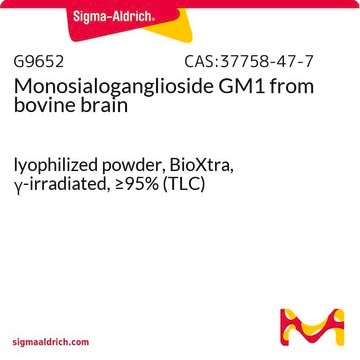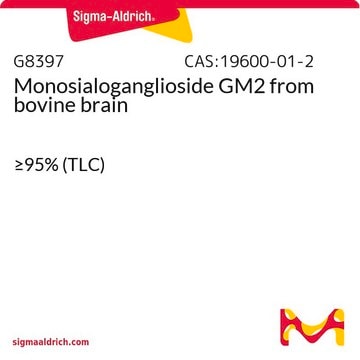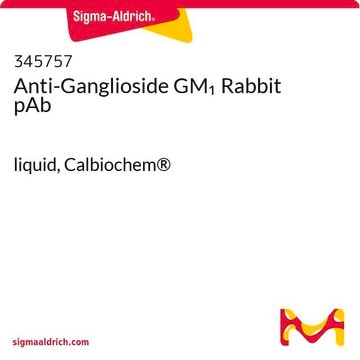Yes, this material is soluble at a minimum of 5 mg/mL in DMSO.
G7641
Monosialoganglioside GM1 from bovine brain
≥95% (TLC), lyophilized powder, sialoglycolipid
Sinônimo(s):
Ganglioside GM1, monosialo
Selecione um tamanho
Selecione um tamanho
About This Item
Produtos recomendados
Nome do produto
Monosialoganglioside GM1 from bovine brain, ≥95%, lyophilized powder
Nível de qualidade
Ensaio
≥95%
Formulário
lyophilized powder
temperatura de armazenamento
−20°C
cadeia de caracteres SMILES
CCCCCCCCCCCCCCCCCCCC(=O)N[C@H](CO[C@@H]1O[C@H](CO)[C@@H](O[C@@H]2O[C@H](CO)[C@H](O[C@@H]3O[C@H](CO)[C@H](O)[C@H](O[C@@H]4O[C@H](CO)[C@H](O)[C@H](O)[C@H]4O)[C@H]3NC(C)=O)[C@H](O[C@@]5(C[C@H](O)[C@@H](NC(C)=O)[C@@H](O5)[C@H](O)[C@H](O)CO)C(O)=O)[C@H]2O)[C@H](O)[C@H]1O)[C@@H](O)\C=C\CCCCCCCCCCCCCCC
InChI
1S/C73H131N3O31/c1-5-7-9-11-13-15-17-19-20-22-24-26-28-30-32-34-52(86)76-44(45(83)33-31-29-27-25-23-21-18-16-14-12-10-8-6-2)40-99-69-61(93)59(91)63(50(38-79)102-69)104-71-62(94)67(98-41-47(85)55(87)66-53(74-42(3)81)46(84)35-73(97,107-66)72(95)96)64(51(39-80)103-71)105-68-54(75-43(4)82)65(57(89)49(37-78)100-68)106-70-60(92)58(90)56(88)48(36-77)101-70/h31,33,44-51,53-71,77-80,83-85,87-94,97H,5-30,32,34-41H2,1-4H3,(H,74,81)(H,75,82)(H,76,86)(H,95,96)/b33-31+/t44?,45?,46-,47?,48+,49+,50+,51+,53+,54+,55?,56-,57-,58-,59+,60+,61+,62+,63+,64-,65+,66+,67+,68-,69+,70-,71-,73-/m0/s1
chave InChI
CNLVNZJJSHZYAS-ALSOZVJRSA-N
Procurando produtos similares? Visita Guia de comparação de produtos
Categorias relacionadas
Amino Acid Sequence
Descrição geral
Aplicação
- in GM1 capture enzyme-linked immunosorbent assay (ELISA)
- for the quantification of cholera toxin B subunit (CTB)-p277 protein accumulation
- for Escherichia coli heat-labile enterotoxin (LT-B) detection
- to determine the affinity of the GM1-ganglioside receptor for the plant-derived Escherichia coli heat-labile toxin LTK63 protein
Ações bioquímicas/fisiológicas
Código de classe de armazenamento
11 - Combustible Solids
Classe de risco de água (WGK)
WGK 3
Ponto de fulgor (°F)
Not applicable
Ponto de fulgor (°C)
Not applicable
Equipamento de proteção individual
Eyeshields, Gloves, type N95 (US)
Escolha uma das versões mais recentes:
Certificados de análise (COA)
Não está vendo a versão correta?
Se precisar de uma versão específica, você pode procurar um certificado específico pelo número do lote ou da remessa.
Já possui este produto?
Encontre a documentação dos produtos que você adquiriu recentemente na biblioteca de documentos.
Os clientes também visualizaram
Artigos
Discover Bioactive Small Molecules for Lipid Signaling Research
-
Is this soluble in DMSO? I see that it is soluble in polar solvents.
1 answer-
Helpful?
-
Active Filters
Nossa equipe de cientistas tem experiência em todas as áreas de pesquisa, incluindo Life Sciences, ciência de materiais, síntese química, cromatografia, química analítica e muitas outras.
Entre em contato com a assistência técnica










